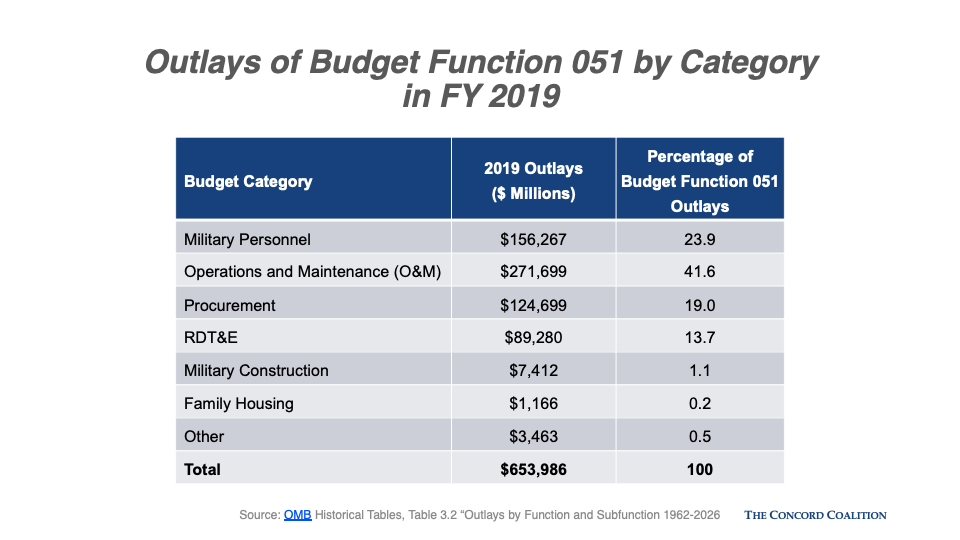Most Americans know that the defense budget constitutes a substantial portion of federal spending, but there remains plenty of confusion as to just how much. While a quick search can answer that for you (spoiler alert: $714 billion in FY 2020 according to the Congressional Budget Office), once you get beyond that simple figure, the waters become murky. How does that compare with the overall federal budget? What do we spend the money on? Is it growing, shrinking, or relatively flat? What role does it play in the fiscal outlook relative to other programs?
These are important questions because the defense budget is important for every voter and taxpayer to understand. So, let’s do our civic duty and go over some important defense budget questions.
What is the “defense budget”?
A common point of confusion regarding the phrase “defense budget” is the actual meaning of the term. Counterintuitively, it does not refer solely to the “Pentagon Budget” which covers just the conventional military spending under the Department of Defense (although this is the largest portion of the defense budget1).
The term “defense budget” is the portion of the federal budget allocated to the National Defense budget function(numerically, function 050), and is the sum of three subfunctions:
Notably, the defense budget does not include:
How does defense fit within the overall federal budget?
One poll from 2010 found that Americans commonly believed that defense spending constituted more than half of all federal spending, with a majority of Americans believing that it constituted more than 30%. In reality, the actual proportion of the federal budget spent on national defense was 19% that year, and it’s even lower today.

Data from 2019 (the most recent outlay data without a COVID-related skewing) shows that defense outlays made up just over 15% of total federal budget outlays that year, roughly equal to 3.2% of GDP.

Some of the confusion regarding the proportion of defense spending in the federal budget may stem from a failure to distinguish between total federal spending and discretionary spending. Discretionary spending is the portion of the budget controlled by the annual appropriations process, which now accounts for about one-third of all outlays. So while the defense budget comprised only 15% of total federal spending in 2019, it also comprised 50% of all discretionary spending. 2
Framing the role of defense spending in the federal budget as a percentage of discretionary spending can lead to a parade of false conclusions about how to remedy our national fiscal crisis, and more importantly, it obscures the role of larger government programs in causing and perpetuating the fiscal crisis.
How is the Pentagon’s budget allocated?
Spending under budget function 051 falls into one of seven buckets:
(1) Military Personnel covers pay and other forms of compensation for servicemembers, including healthcare contributions;
(2) Operations and Maintenance (O&M) covers the costs of operations, a large portion of DoD civilian compensation, and the costs of the military healthcare system;
(3) Procurement covers the costs of acquiring weapons systems and technologies;
(4) Research, Development, Testing, and Evaluation (RDT&E) covers the costs of creating and validating new weapons systems and technologies;
(5) Military Construction covers the costs of constructing buildings, piers, and other critical infrastructure for the military;
(6) Family Housing covers the costs of building and maintaining housing for the families of servicemembers on military installations; and
The table below illustrates the contributions of each category to total spending within budget function 051.

As the table above illustrates, Operations and Maintenance comprises the largest portion of the Pentagon Budget, followed by Military Personnel. These two categories cover the majority of costs related to staffing and executing military operations, as well as the military healthcare system. Combined, O&M and Military Personnel comprise roughly two-thirds of the Pentagon Budget.
Procurement and RDT&E combine to comprise another third of the Pentagon spending. These categories can be consolidated under the moniker of “acquisitions”, the purpose of which is to equip and arm the military with the weapons systems, technologies, vehicles, and other equipment necessary to execute its missions.
Military Construction and Family Housing are sometimes grouped together and called “infrastructure” and combined they typically account for about one percent of Pentagon Spending.
Stay tuned for part 2 of this defense primer when The Concord Coalition analyzes the Biden defense budget for FY 2022.
Footnotes
1 Although most of DoD spending is covered in National Defense (050) spending, under the subfunction Department of Defense – Military (051), some of it is spread among other budget functions. See this Congressional Research Service primer for more information on this and other National Defense (050) issues.
2 Discretionary spending used to consume half of the federal budget but has shrunk to one-third. The remaining 70% of total federal spending is composed of mandatory expenditures on entitlements such as Social Security (23%), Medicare (17%), Medicaid (9%), other mandatory programs (13%), and interest on the national debt (8%).
Continue Reading







